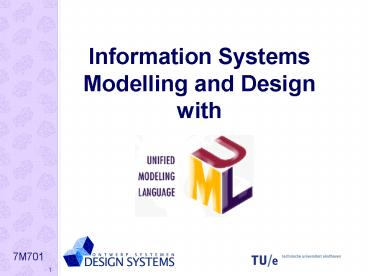Information Systems Modelling and Design with - PowerPoint PPT Presentation
1 / 13
Title:
Information Systems Modelling and Design with
Description:
... The Unified Modeling Language User Guide Web: www.omg.org www.popkin.com UML? 1 UML is the successor to the wave of object-oriented analysis and design ... – PowerPoint PPT presentation
Number of Views:155
Avg rating:3.0/5.0
Title: Information Systems Modelling and Design with
1
Information Systems Modelling and Design with
2
Objectives
- Getting acquaint with the visual modelling
language UML (Unified Modelling Language) - Able to design an information system using UML
3
Study matter
- Books
- Fowler Scott UML distilled 2nd ed
- Booch, Rumbauch Jacobson The Unified Modeling
Language User Guide - Web
- www.omg.org
- www.popkin.com
4
UML? 1
- UML is the successor to the wave of
object-oriented analysis and design (OOAD)
methods. The methods of Booch, Rumbaugh and
Jacobson (de 3 amigos) are merged. UML
represents the culmination of best practices in
practical object-oriented modelling. - UML offers a standard way to write a systems
blueprints, including conceptual things such as
business processes and system functions as well
as database schemas.
5
UML? 2
- UML is a modelling language, a notation used to
express and document designs. - UML proposes a standard for technical exchange of
models and designs. - UML also defines a meta-model, a diagram that
defines the syntax of the UML notation
6
UML Model Views
- Use Case Modelling
- Requirements
- Use Case diagrams
- Structural Modelling
- Static structure diagrams
- Class diagrams
- Object diagrams
- Behaviour Modelling
- State diagrams
- Interaction diagrams
- Sequence diagrams
- Collaboration diagrams
- Activity diagrams
- Implementation diagrams
7
UML what we will cover
- Use cases
- Documenting the systems behaviour from the
users viewpoint, requirements capture - Class diagrams
- Describing the type of objects in a system and
the static relationships between them - Activity diagrams
- Describing the sequencing of activities with
support for both conditional and parallel
behaviour
8
Relationship between diagrams
9
UML steps
- Examine the necessities of the information system
? use cases - Object-oriented domain analysis ? decomposition
of the problem field in concepts, attributes and
associations that may be of relevance to the
information system
End
10
Back
11
Back
12
Back
13
End of Intro































